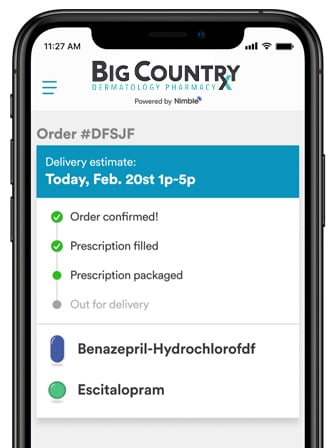Here at claRx Big Country Dermatology pharmacy, we work in a symbiotic relationship with the manufacturers that make many of the medications we dispense. We do this by participating in their rebate programs, which are designed to reduce the out of pocket cost to patients on specific medications. Manufacturer rebates are not available for all medications, and they do not help every patient. We believe it is our duty in the dermatology industry to do the most good for most people, which means, when these programs are available for a specific patient, we utilize them.
Utilizing Manufacturer Rebates
Utilizing manufacturer rebates allows us to reduce a patient's copay dramatically. For example, a patient's copay can drop from $400 to $40 when they utilize a rebate. That is a big win for our patients and why we train every team member to understand these programs so that they can help those patients save money.
Let's go over an example that shows us how we can help a patient save hundreds of dollars on their prescriptions.
- A patient is prescribed a topical medication that is expected to be used on a consistent basis going forward. The medication costs them $400 per month, and their commercial insurance has a deductible of $2,000. Along with the cost of their medications, the patient has to worry about the costs associated with visiting the doctor's office. All of these costs add up quickly, and we are only in the month of March! Fortunately, the manufacturer is willing to cover $340 of the patient’s copay because they will most likely meet their deductible by the 3rd month on the medication. The manufacturer has a margin of $200 on each medication that is covered when they do not pay part of the co-pay.
- Now, we are in the month of June, and the manufacturer has paid out $1,020 and the patient will be on the medication for 6 more months. By the end of the year, the manufacturer will have generated $180 in profit on that patient. The patient will likely continue using the medication the following year where the manufacturer projects to make $300 on that patient. In this example, you can see why a manufacturer would pay for a patient's copay and how it can be a win-win for both parties. As the patient's pharmacy, it is our job to make sure each patient is informed of these programs, and has the opportunity to take advantage of them when they are able to. We do this by continually working with the manufacturers and their programs.
It is worth noting that these programs do change often and are medication specific. Not all pharmacies run these programs, and some of them aren't even aware that they exist.
Situations Where Patients Can't Use Rebates
Now, let's go over a couple of situations that can make patients unable to participate in these rebate programs.
- The most common situation that excludes a patient from being able to take advantage of a manufacturer's rebate program is when the patient has insurance through a government-backed plan such as Medicare, Medicaid, or Tricare.
- The next large group of people that can potentially be excluded from the programs is patients that have no prescription insurance. While some rebate programs do cover these individuals, many do not. A possible reason for this is that the manufacturer believes that they will lose money on these prescriptions when they can not afford to do so.
- A more rare situation that can cause patients to be unable to participate in the program is when they're commercial insurance plan does not have the medication listed on their formulary and is thereby not covered. We refer to this as, "the medication is not covered." In these instances, for all intents and purposes from the manufacturer's perspective, these patients are equal to a patient with no insurance coverage.
- The last group of patients that are sometimes excluded from these programs are the patients that have commercial insurance, and the medication is on the formulary, and they have a high deductible that is often three thousand dollars or more. From the manufacturer's perspective, they have to decide if they think this patient is likely to reach the deductible. If they're based on the medication they are trying to acquire, the manufacturer will likely include these individuals on the rebate plan. If they are not, they are much more likely to exclude them since the manufacturer might think of them more as a cash pay type of patient.
The manufacturer is happy for cash pay patients to obtain and use their medication when a provider deems it appropriate. Most manufacturers can not pay for the majority of their medication if, by their estimations, it is not a profitable endeavor over the long term as all businesses must make a profit to survive.
How Can A Manufacturer Pay Part of a Copay?
The reason a manufacturer can pay for part of the patient's copay when the patient has insurance is if they are only paying a small amount of the copay and they still have a margin within the medication to stay profitable, or if they are paying the majority of the medication cost. They believe once the patient meets their deductible, they will then be able to make up the lost money upfront on the later refills of the medication.
We are always looking for ways to help the patient, and utilizing manufacturers rebates is one of them. Here at claRx Big Country Dermatology Pharmacy, we strive to make a positive difference in patients lives.



